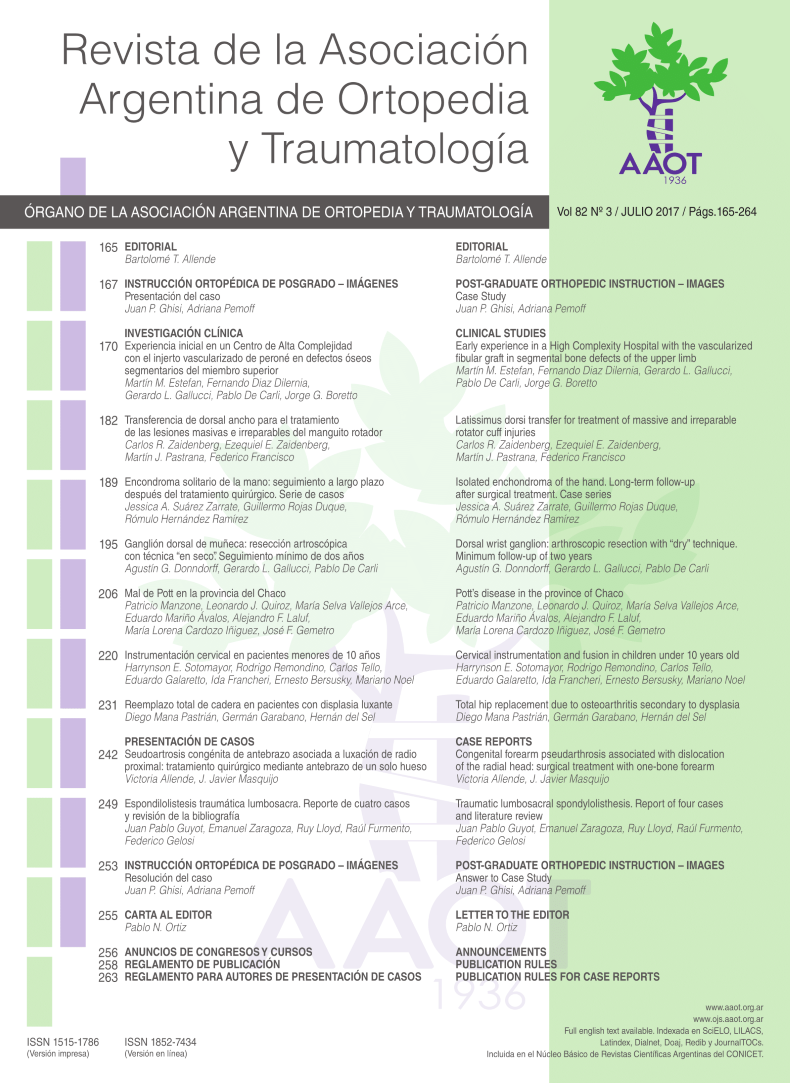Experiencia inicial en un centro de alta complejidad con el injerto vascularizado de peroné en defectos óseos segmentarios del miembro superior. [Early experience in a high complexity Hospital with the vascularized fibular graft in segmental bone defects of the upper limb.]
Contenido principal del artículo
Resumen
Descargas
Métricas
Detalles del artículo

Esta obra está bajo licencia internacional Creative Commons Reconocimiento-NoComercial-CompartirIgual 4.0.
La aceptación del manuscrito por parte de la revista implica la no presentación simultánea a otras revistas u órganos editoriales. La RAAOT se encuentra bajo la licencia Creative Commons 4.0. Atribución-NoComercial-CompartirIgual (http://creativecommons.org/licenses/by-nc-sa/4.0/deed.es). Se puede compartir, copiar, distribuir, alterar, transformar, generar una obra derivada, ejecutar y comunicar públicamente la obra, siempre que: a) se cite la autoría y la fuente original de su publicación (revista, editorial y URL de la obra); b) no se usen para fines comerciales; c) se mantengan los mismos términos de la licencia.
En caso de que el manuscrito sea aprobado para su próxima publicación, los autores conservan los derechos de autor y cederán a la revista los derechos de la publicación, edición, reproducción, distribución, exhibición y comunicación a nivel nacional e internacional en las diferentes bases de datos, repositorios y portales.
Se deja constancia que el referido artículo es inédito y que no está en espera de impresión en alguna otra publicación nacional o extranjera.
Por la presente, acepta/n las modificaciones que sean necesarias, sugeridas en la revisión por los pares (referato), para adaptar el trabajo al estilo y modalidad de publicación de la Revista.
Citas
2. Taylor G, Miller G, Ham F. The free vascularized bone graft: A clinical extension of microvascular techniques. Plast Reconstr Surg 1975;55:533.
3. Masquelet AC. The Concept of Induced Membrane for Reconstruction of Long Bone Defects. Orthop Clin N Am 41 (2010) 27–37.
4. Hollenbeck S, Levin LS. The current role of the vascularized-fibular osteocutaneous graft in the treatment of segmental defects of the upper extremity. Microsurgery 31:183–189, 2011.
5. Chen Z, Yan W. The study and clinical application of the osteocutaneous flap of fibula. Microsurgery 1983;4:11–16.
6. Mattar R, Azze RJ, Castro Ferreira M, Starck R, Canedo AC. Vascularized fibular graft for management of severe osteomyelitis of the upper extremity. Microsurgery 1994;15:22_27.
6. Heitmann C, Erdmann D, Levin L. Treatment of segmental defects of the humerus with an osteoseptocutaneous fibular transplant. J Bone Joint Surg Am 2002;84:2216–2223.
7. Heitmann C, Erdmann D, Levin L. Treatment of segmental defects of the humerus with an osteoseptocutaneous fibular transplant. J Bone Joint Surg Am 2002;84:2216–2223.
8. Wood MB. Upper extremity reconstruction by vascularized bone transfers: results and complications. J Hand Surg [Am]. 1987;12:422-7.
9. Guo Q, Xu Z, Wen S, Liu Q, Liu S, Wang J et al. Value of a skin island flap as a postoperative predictor of vascularized fibular graft viability in extensive diaphyseal bone defect reconstruction. Orthop Traumatol Surg Res. 2012; 98(5):582.
10. Gilbert A. Free vascularized bone grafts. Intern Surg 1991;66:27–31.
11. Jupiter JB, Gerhard HJ, Guerrero JA, Nunley J, Levin LS. Treatment segmental defects of the radius with use of the vascu vascularized osteoseptocutaneous fibular autogenous graft. J Bone Joint Surg [Am] 1997;79:542_550.
12. Vail TP, Urbaniak JR. Donor-site morbidity with use of vascularized autogenous fibular grafts. J Bone Joint Surg Am. 1996 Feb;78(2):204-11.
13. Gaskill TR, Urbaniak JR, Aldridge JM 3rd. Free vascularized fibular transfer for femoral head osteonecrosis: donor and graft site morbidity. J Bone Joint Surg Am. 2009 Aug;91(8):1861-7.
14. Soucacos PN, Dailiana Z, Beris AE, Johnson EO. Vascularized bone grafts for the management of nonunion. Injury 2006;37:S41–50.
15. Soucacos PN, Johnson EO, Babis G. An update on recent advances in bone regeneration. Injury 2008;39:S1–4.
16. Soucacos PN. The free vascularized fibular graft for bridging large skeletal defects of the upper extremity. Microsurgery 31:190–197, 2011.
18. Enneking WF, Eady JL, Burchardt H. Autogenous cortical bone graft in the reconstruction of segmental defects. J Bone Joint Surg. 1980;62-A(7):1039–58.
19. Obert L. Induced membrane technique (masquelet technique) to treat bone defects at upper limb prospective multicentre evaluation.Bone Joint J Dec 2014, 96-B (SUPP 19) 47.
20. Villa A, Paley D, Catagni MA, Bell D, Cattaneo R. Lengthening of the forearm by the Ilizarov tecnique. Clin Orthop 1990;250:125137.
21. Emara KM. Ilizarov technique in management of non united fracture of both bones of the orearm. J Orthop Traumatol 2002;3:177180.
22. Adani R. Reconstruction of large postraumatic skeletal defects of the forearm by vascularized free fibular graft. Microsurgery 24:423–429, 2004.
23. de Boer HH, Wood MB. Bone changes in the vascularised fibular graft. JBone Joint Surg Br. 989;71:374-8.
24. Del Piñal F, Innocenti M. Evolving concepts in the management of the bone gap in the upper limb. Long and small defects. J Plast Reconstr Aesthet Surg 2007;60:776–792
25. de Boer HH, Wood MB, Hermans J. Reconstruction of large skeletal defects by vascularized fibula transfer: factors that influenced the outcome of union in 62 cases. Int Orthop. 1990;14:121–8.
26. Gebert C, Hillmann A, Schwappach A, Hoffmann C, Hardes J, Kleinheinz J, Gosheger G. Free vascularized fibular grafting for reconstruction after tumor resection in the upper extremity. J Surg Oncol 2006;94:114.
27. Noaman H. Management of upper limb bone defects using free vascularized osteoseptocutaneous fibular bone graft. Ann Plast Surg. 2013; 71(5):503-509.

